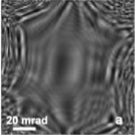Machine Learning-based tuning of Electron Microscopes
Today’s electron microscopes are complicated devices with aberration correction involving hundreds of optical elements like those found in accelerators and synchrotrons. The beam alignment can only be effectively monitored at the end of the column, usually using a interferogram called a Ronchigram (see figure) that maps the phase variation of the beam versus scattering angle. One challenge to tuning is that the aberrations are poorly behaved, with cusp-like minima that are very unstable, and as a result, full tuning is tedious and requires hours of effort even for an expert.
To address the problem, CBB postdoc Chenyu Zhang showed that emittance (the volume of phase space occupied by the beam) is an alternate metric of beam quality and is better behaved than the aberration function. Next, he applied Bayesian optimization techniques to automatically tune the 81 correcting lenses related to the octupole aberration in a NION UltraSTEM microscope. Tuning was rapid, taking less than 2 minutes, gave results as good as the current hand-tuning, and required no operator experience.
CBB is now applying these techniques to other aberrations and microscopes. Once this is done, the goal is to transfer these methods to microscope companies, so that future microscopes can be automatically tuned, and users can avoid expensive and time-consuming visits by company experts.
References:
C. Zhang, Z. Baraissov, C. Duncan, A. Hanuka, A. Edelen, J. Maxson, D. Muller, "Aberration Corrector Tuning with Machine-Learning-Based Emittance Measurements and Bayesian Optimization", Microsc. Microanal 27 (S1), 810 (2021) [Online] Available: https://doi.org/10.1017/S1431927621003214
C. Zhang, Yu-Tsun Shao, Z. Baraissov, C. Duncan, A. Hanuka, A. Edelen, J. Maxson, D. Muller, "Bayesian Optimization for Multi-dimensional Alignment: Tuning Aberration Correctors and Ptychographic Reconstructions", Microsc. Microanal. 28 (S1), 3146 (2022) [Online] Available: https://doi.org/10.1017/S1431927622011692

